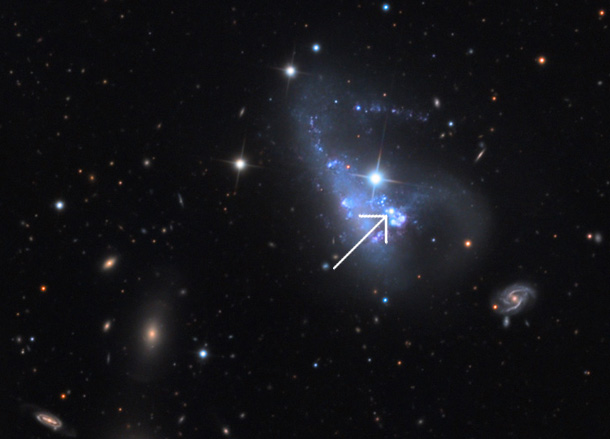Create a free profile to get unlimited access to exclusive videos, sweepstakes, and more!
Spectacular site for Supernova 2012A

The first supernova of the year was spotted a couple of weeks ago: Supernova 2012A, in the galaxy NGC 3239 in the constellation of Leo. Adam Block of the Mount Lemmon SkyCenter took a phenomenal image of it:
[Click to corecollapsenate.]
Funny, the supernova isn't what you'd expect; it's not that really bright star (which is probably a star in our own galaxy that happens to be superposed on the galaxy) but instead the fainter one indicated. Images taken years ago show no sign of the new star.
The galaxy is called NGC 3239 (or Arp 263), and is a weird galaxy technically classified as irregular. Its distance isn't well known, but it's something like 25 million light years away or so. I imagine we'll get a better distance determination very soon, since that's important in understanding how much energy a supernova puts out.
The shape of the galaxy is probably the result of the collision of two separate galaxies which are still in the process of merging. The odd shape is a consequence of that. The pinkish glow is from gas clouds actively forming stars, and the overall blue tinge is from massive, hot, young stars, again probably triggered by the galaxy collisions. In fact, SN 2012A is the type of supernova formed when a massive star explodes, and these are short-lived stars.
The supernova is bright enough to be spotted in amateur-astronomy sized telescopes, so it's getting some attention, like here and here and here. Adam Block has access to a telescope nearly a meter across which is equipped with an excellent camera, so his image is spectacular. I love all the background galaxies as well; we're looking well away from the obscuring dust and junk floating around in our own galaxy, as well as toward a part of the Universe littered with distant galaxies.
It used to be that only a few dozen supernovae were discovered in a year, so the first one of a new year may not have been found for some time. Supernova 1987A -- which I studied for my PhD -- was the first one in 1987 and it was seen in the third week of February! Now, with robotic telescopes sweeping the skies with exquisite sensitivity, it's rare to go a whole week in the new year without discovering one. And this is a numbers game: the more supernovae we find, the better we can understand them.
Image credit: Adam Block/Mount Lemmon SkyCenter/University of Arizona, used with permission.
Related posts:
- New pic: SN2011fe in M101
- Betelgeuseâs sandy gift
- A supernova is reborn
- Blast site blastocyte















